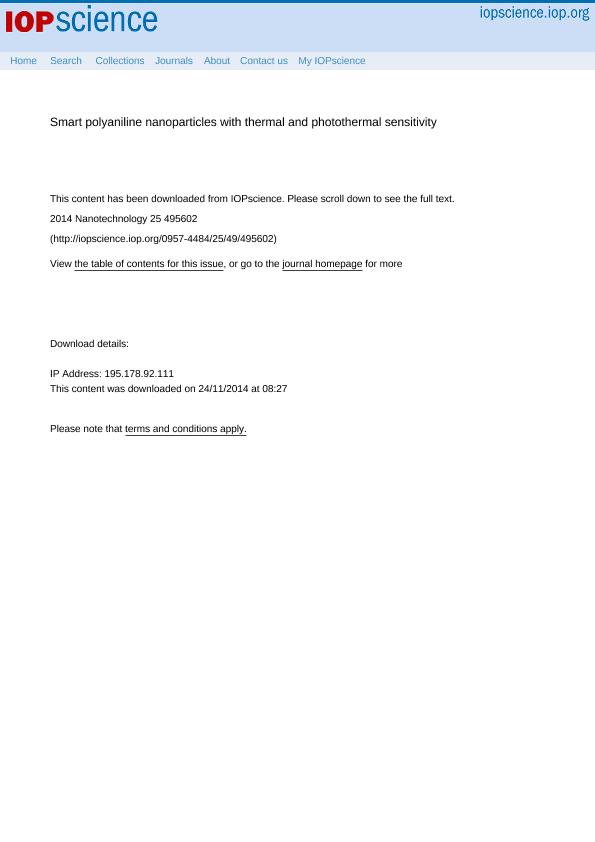Mostrar el registro sencillo del ítem
dc.contributor.author
Bongiovanni Abel, Silvestre Manuel

dc.contributor.author
Molina, María Alejandra

dc.contributor.author
Rivarola, Claudia Rosana

dc.contributor.author
Kogan, Marcelo Javier

dc.contributor.author
Barbero, César Alfredo

dc.date.available
2018-01-26T20:35:04Z
dc.date.issued
2014-11
dc.identifier.citation
Bongiovanni Abel, Silvestre Manuel; Molina, María Alejandra; Rivarola, Claudia Rosana; Kogan, Marcelo Javier; Barbero, César Alfredo; Smart polyaniline nanoparticles with thermal and photothermal sensitivity; IOP Publishing; Nanotechnology; 25; 49; 11-2014; 1-9; 495602
dc.identifier.issn
0957-4484
dc.identifier.uri
http://hdl.handle.net/11336/34777
dc.description.abstract
Conductive polyaniline nanoparticles (PANI NPs) are synthesized by oxidation of aniline with persulfate in acid media, in the presence of polymeric stabilizers: polyvinilpyrrolidone (PVP), poly(N-isopropylacrylamide) (PNIPAM), and hydroxylpropylcellulose (HPC). It is observed that the size of the nanoparticles obtained depends on the polymeric stabilizer used, suggesting a mechanism where the aggregation of polyaniline molecules is arrested by adsorption of the polymeric stabilizer. Indeed, polymerization in the presence of a mixture of two polymers having different stabilizing capacity (PVP and PNIPAM) allows tuning of the size of the nanoparticles. Stabilization with biocompatible PVP, HPC and PNIPAM allows use of the nanoparticle dispersions in biological applications. The nanoparticles stabilized by thermosensitive polymers (PNIPAM and HPC) aggregate when the temperature exceeds the phase transition (coil to globule) temperature of each stabilizer (Tpt = 32 °C for PNIPAM or Tpt = 42 °C for HPC). This result suggests that an extended coil form of the polymeric stabilizer is necessary to avoid aggregation. The dispersions are reversibly restored when the temperature is lowered below Tpt. In that way, the effect could be used to separate the nanoparticles from soluble contaminants. On the other hand, the PANI NPs stabilized with PVP are unaffected by the temperature change. UV-visible spectroscopy measurements show that the nanoparticle dispersion changes their spectra with the pH of the external solution, suggesting that small molecules can easily penetrate the stabilizer shell. Near infrared radiation is absorbed by PANI NPs causing an increase of their temperature which induces the collapse of the thermosensitive polymer shell and aggregation of the NPs. The effect reveals that it is possible to locally heat the nanoparticles, a phenomenon that can be used to destroy tumor cells in cancer therapy or to dissolve protein aggregates of neurodegenerative diseases (e.g. Alzheimer). Moreover, the long range control of aggregation can be used to modulate the nanoparticle residence inside biological tissues.
dc.format
application/pdf
dc.language.iso
eng
dc.publisher
IOP Publishing

dc.rights
info:eu-repo/semantics/openAccess
dc.rights.uri
https://creativecommons.org/licenses/by-nc-sa/2.5/ar/
dc.subject
Conductive Polyaniline Nanoparticles
dc.subject
Thermosensitive Polymers
dc.subject
Near Infrared Radiation
dc.subject
Potothermal Effect
dc.subject
Agregation
dc.subject.classification
Otras Ciencias Químicas

dc.subject.classification
Ciencias Químicas

dc.subject.classification
CIENCIAS NATURALES Y EXACTAS

dc.title
Smart polyaniline nanoparticles with thermal and photothermal sensitivity
dc.type
info:eu-repo/semantics/article
dc.type
info:ar-repo/semantics/artículo
dc.type
info:eu-repo/semantics/publishedVersion
dc.date.updated
2018-01-24T14:43:59Z
dc.journal.volume
25
dc.journal.number
49
dc.journal.pagination
1-9; 495602
dc.journal.pais
Reino Unido

dc.journal.ciudad
Londres
dc.description.fil
Fil: Bongiovanni Abel, Silvestre Manuel. Universidad Nacional de Río Cuarto; Argentina. Consejo Nacional de Investigaciones Científicas y Técnicas; Argentina
dc.description.fil
Fil: Molina, María Alejandra. Universidad Nacional de Río Cuarto; Argentina. Consejo Nacional de Investigaciones Científicas y Técnicas; Argentina
dc.description.fil
Fil: Rivarola, Claudia Rosana. Universidad Nacional de Río Cuarto; Argentina. Consejo Nacional de Investigaciones Científicas y Técnicas; Argentina
dc.description.fil
Fil: Kogan, Marcelo Javier. Universidad de Chile; Chile
dc.description.fil
Fil: Barbero, César Alfredo. Universidad Nacional de Río Cuarto; Argentina. Consejo Nacional de Investigaciones Científicas y Técnicas; Argentina
dc.journal.title
Nanotechnology

dc.relation.alternativeid
info:eu-repo/semantics/altIdentifier/doi/http://dx.doi.org/10.1088/0957-4484/25/49/495602
dc.relation.alternativeid
info:eu-repo/semantics/altIdentifier/url/http://iopscience.iop.org/article/10.1088/0957-4484/25/49/495602/meta
Archivos asociados
